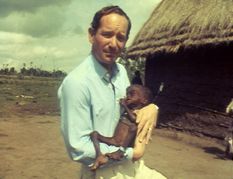
|
|

The images spawned the biggest simultaneous global fund-raising project
of all time and, in the process, the world’s most famous rock concert, Live
Aid.
The late Mo Amin’s haunting pictures of starving Ethiopians, accompanying Michael Buerk’s moving reports 20 years ago on BBC TV News, became instantly recognized as the iconic representation of disaster and famine.
And that, argue some, is now a problem. Because, two decades on, photo-reportage of similar events today remains very much the same and, as a result, poses questions about its effectiveness.
It is this concern that has led to Imaging Famine, a project and exhibition to
be staged at The Newsroom gallery in London from August
4 until September 9 2005.
"This project will detail how famine has been historically pictured in the
print media, from the nineteenth century to the present day,” explains one
of the organizers, photographer and academic DJ Clark. “Its aim is to raise
questions about compassion fatigue, iconic and stereotypical images, and the political
effect of such photographs.”
“The Michael Buerk reports were a watershed”, says another of the organizers, Geography Professor David Campbell of Durham University in England. “After that, the NGOs said that they should never use the same kind of images again to illustrate problems in Africa – the Madonna like figures of starving mothers with their equally emaciated children. But they have done and continue to do so.”
“Ironically, some of the pictures in Michael Buerk’s pieces would probably not be used on the 10 O’clock News now because they would be considered too graphic for today’s audiences, “ Professor Campbell explained further.
“What perpetuates these kinds of images is the preference of picture editors on newspapers and magazines for them and, of course, photographers need to have their pictures used. But photographers should think about the context of their photos – concentrating perhaps not so much on the particular but on the general to illustrate the problem – and find extra outlets for the work they’d like to see used, such as the Internet. There should also be greater critical analysis of how pictures like these are utilized in the media.”
DJ Clark, who teaches photography at Bolton University in England, says the increasing number of indigenous photographers covering such stories now is encouraging, rather than it always being photojournalists from the developed world. But although they have a greater understanding of the areas in which they work, local photographers do still tend to provide the kinds of images demanded by picture editors, tailored for Western markets, particularly the US. He hoped that this would gradually change.
A one-day conference is also being organized on September 6 in conjunction with the Imaging Famine exhibition.
“Its purpose is to bring together people who create, edit, employ and study images of humanitarian disaster in the developing world to discuss issues concerning their content, style and use”, says DJ Clark.
Details of the exhibition, conference participants and information on how to book a place can be found at www.imaging-famine.org.
If you have any views on this issue's Talking Point, please send a
brief email and a selection of what you say will be published in the next
issue.
Click link to external site:
The Newsroom
Gallery
|
|


Michael Buerk reports for BBC TV News from Ethiopia in 1985.




|
|
